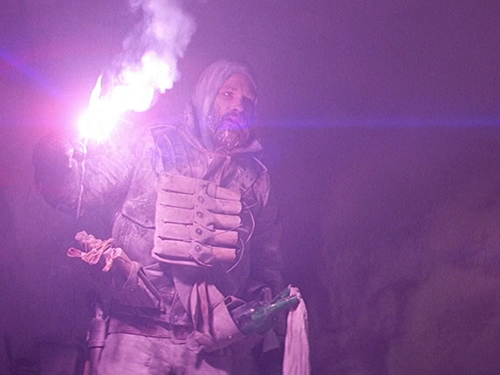
A research team in Antarctica is hunted by a shape-shifting alien that assumes the appearance of its victims. The film was a re-make of The Thing from Another World (1951) by director Christian Nyby, although it is usually attributed to its producer Howard Hawks.
“Primal myth and modern delusion joined in their assumption that mankind is only one – perhaps the least – of the highly evolved and dominant races of this planet’s long and largely unknown career. Things of inconceivable shape, they implied, had reared towers to the sky and delved into every secret of Nature before the first amphibian forebear of man had crawled out of the hot sea three hundred million years ago. Some had come down from the stars; a few were as old as the cosmos itself; others had arisen swiftly from terrene germs as far behind the first germs of our life-cycle as those germs are behind ourselves. Spans of thousands of millions of years, and linkages with other galaxies and universes, were freely spoken of. Indeed, there was no such thing as time in its humanly accepted sense.”
H. P. Lovecraft, The Shadow Out of Time1
“The transformation of human flesh has been extended to that of animals. In a cage, the dog is beginning its violent rebirth. As was the fate of the Norwegian, the dog’s face is fragmenting. Where a face should be, we are now confronted with the interior of the flesh, the sides of the face peeled back like an over-ripened fruit. As its face disappears, tentacles sprout aggressively from the dog’s back. Within a moment, the tentacles themselves transform into a set of insect legs. Little remains of the original dog, save its coat, which is now bloodied by its mutilation. Hearing the commotion of flesh revealing itself, the men investigate: ‘I don’t know what the hell’s in there,’ remarks one of the team, ‘but it’s weird and pissed off, whatever it is.’ Mac opens the gate, and the dog gazes toward the flashlight. It has become a gelatinous mass with no discernable form. Here, the claw of a dog, there the blinking eye of a human. Indeed, the thing is less a creature and more a composite of different lifeforms arbitrarily bound by being constituted from the same elemental stuff: flesh. [...] ‘There is,’ so Lacan writes, ‘a horrendous discovery here, that of the flesh one never sees, the foundation of things, the other side of the head, of the face, the secretory glands par excellence, the flesh from which everything exudes, at the very heart of the mystery, the flesh in as much as it is suffering, is formless, in as much as form in itself is something which provokes anxiety. Spectre of anxiety, identification of anxiety, the final revelation of you are this – You are this, which is so far from you, this which is the ultimate formlessness’”
Dylan Trigg2
John Carpenter: [...] Bill wrote the screenplay with the monster in shadows, the old Hollywood cliché stuff, which everybody still talks about even to this day. Rob Bottin was the guy who said, “No, you’ve got to put him in the light, then the audience really goes nuts. They really go nuts because there it is in front of them.” I wasn’t sure, but that’s what we did.
Erik Bauer: The critics really hammered that aspect of it.
I’ve always thought that was somewhat unfair. I mean, the whole point of the monster is to be monstrous, to be repellent. That’s what makes you side with the human beings. I didn’t have a problem with that. The critics thought the movie was boring and didn’t allow for any hope. That was the part they really hammered on. The lack of hope is built into the story. There is an inevitability to it, but that’s not necessarily a negative. Well, in the short story the humans clearly win, but then they look up and wonder if the Thing got to the birds and they’re flying to the mainland. It was just a question mark that wasn’t quite the two men freezing to death in the snow to save humanity. I thought that was the ultimate heroic act, but audiences didn’t see it that way. I remember the studio wanted some market research screenings and after one I got up and talked to the audience about what they thought of the film. There was one young gal who asked, “Well what happened in the very end? Which one was the Thing, and which one was the good guy?” And I said, “Well, you have to use your imagination.” And she said, “Oh, God. I hate that.”
John Carpenter in an interview with Erik Bauer3
“When it actually arrives, capitalism brings with it a massive desacralization of culture. It is a system which is no longer governed by any transcendent Law; on the contrary, it dismantles all such codes, only to re-install them on an ad hoc basis. The limits of capitalism are not fixed by fiat, but defined (and re-defined) pragmatically and improvisationally. This makes capitalism very much like the Thing in John Carpenter’s film of the same name: a montrous, infinitely plastic entity, capable of metabolizing and absorbing anything with which it comes into contact.”
Mark Fisher4
- 1Quoted in Dylan Trigg, The Thing. A Phenomenology of Horror (Hampshire: Zero Books, 2014), 7.
- 2Dylan Trigg, The Thing. A Phenomenology of Horror (Hampshire: Zero Books, 2014)
- 3Erik Bauer, “Interview with John Carpenter,” Creative Screenwriting, January/February 1999. Via Cinephilia and Beyond, where an elaborate collage of interviews and images on Carpenter’s The Thing can be found.
- 4Mark Fisher, Capitalist Realism (Hampshire: Zero Books, 2009), 6.

